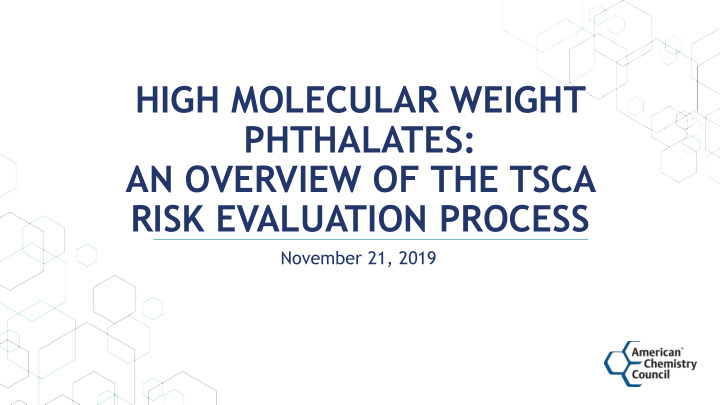



HIGH MOLECULAR WEIGHT PHTHALATES: AN OVERVIEW OF THE TSCA RISK EVALUATION PROCESS November 21, 2019
Agenda Introduction to Phthalates Uses State of the Science and Regulatory Reviews v Risk Evaluations under TSCA v
Why then would we treat all phthalates as if they were the same? Term “phthalate” represents a family of structurally similar substances • Differentiated into low and high molecular weight categories • Typically C 1 -C 13 single (DEHP) or mixed isomers (DINP) o CH 3 Not interchangeable o DMP Dimethyl 3-6 carbon atoms in backbone – C 1 -C 4 – solvents (volatility) o phthalate DEHP >C 4 used as plasticizers o Reproductive effects in animals Alcohol Phthalic Acid C 8 H 17 DEHP Di-2-ethylhexyl ROH phthalate Esterification Plasticizer C 9 -rich Alcohol backbone chain length makes the o DINP Diisononyl difference - Technical & toxicological properties phthalate ≥7 carbon atoms in Longest chain within backbone – e.g. DINP the R-group No reproductive effects i.e. DEHP longest chain is the hexyl group (C6)
Structural differences in the 5 EPA high priority phthalates are reflected in existing regulatory determinations BBP, DBP, DIBP, DEHP, DCHP LMW Classified as category 1B reprotoxicants under EU REACH DINP, DIDP, DNOP DINP / DIDP – Safe in all current HMW EU CLP – Not classified applications US CPSC – Safe margin of o ECHA exposure found for DINP, DIDP o Health Canada – “low risk” and DNOP individually o Australia NICNAS – no toy restrictions
DINP & DIDP toy restrictions are precautionary and do not reflect a credible health risk Toy restrictions are precautionary – 2017 risk assessment concludes no concern for use in toys Toy restrictions based on spongiosis hepatis lesions found only in aging rats and teleost fish. Canada EU US DIDP no longer restricted in toys DINP restriction based on questionable cumulative risk assessment Australia No toy restrictions based on lack of risk
The safety of DINP & DIDP has been reviewed extensively over the past 20 years 2003 – “ there is at present no need for further information and/or testing for risk reduction measures beyond those which are being applied already ” 2017 – “ low risk of harm …” 2014 – “ no unacceptable risk has been characterized for the uses of DINP and DIDP in articles other than toys and childcare Canada articles which can be placed in the mouth ” EU 2018 – no basis to classify DINP for US reproductive / developmental effects 2001 – “ no demonstrated health risk ” from use of DINP in toys 2003 – “ minimal and negligible concern ” for reproductive / developmental toxicity of DINP & DIDP 2017 – toy and childcare Australia 2012 & 2015 – No health concern from exposure of restrictions on DIDP lifted – “risks children to DINP & DIDP in toys and childcare articles of use are low” even at the highest exposure scenario considered
Risk Evaluation: Statutory Requirements • EPA must establish by rule a process for risk evaluation o Determine if a chemical presents an unreasonable risk of injury to health or the environment under conditions of use o Without consideration of cost or other non-risk factors o Including unreasonable risk to potentially exposed or susceptible subpopulation(s) determined to be relevant to the evaluation • This process must be completed within 3 – 3.5 years • For each risk evaluation completed, EPA must designate a new high-priority chemical (the culmination of the prioritization process) • By December of 2019, EPA must have 20 chemicals designated as high-priority and undergoing risk evaluation o Additional risk evaluations may come from manufacturer requests
Prioritization EPA will conduct a risk-based screening of all active • chemicals from the inventory to identify those in need of a full evaluation If more information is needed, EPA can request additional • testing and data Low Priority Chemicals: High Priority Chemicals: Remain in use without • Require a risk evaluation • further action • First 10 must be from TSCA Work Plan • Can be reprioritized based For each risk evaluation completed, • on new information at any EPA must designate a new high time priority chemical
Manufacturer Requests Conditions of use – Manufacturers may request a risk evaluation for only uses of interest. EPA will identify other conditions of use that warrant inclusion in the risk evaluation. Request FR Public received YES Publication 45-day notification by EPA (with 60 days of comment of request receipt of a period Grant – The (within 15 days of facially facially compliant risk evaluation compliant EP A ’s request) will be initiated request) upon payment Determination of fees of facial EP A ’s decision completeness (within 60 days Requester may of the end of the NO resubmit an comment period) Deny updated request
Risk Evaluation High Priority chemicals will undergo a full evaluation of hazards , uses , exposure , to determine risk Risk Evaluations must: Be based solely on health & environmental information • Consider a chemical’s conditions of use • Consider risks to vulnerable groups • Rely on the best available and weight of scientific evidence • *EPA can again request more information & data if needed. Do you know the difference between hazard & risk?
More Resources https://phthalates.americanchemistry.com/ https://www.chemicalsafetyfacts.org/phthalates/ https://www.mindthescience.org/chemicals-in- products/phthalates
For more information please visit www.phthalates.org Or contact: Eileen Conneely 202-249-6711 eileen_conneely@AmericanChemistry.com
Questions?
Recommend
More recommend